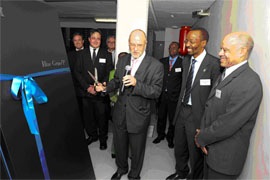At the EGEE User Forum in Uppsala, the author, Bruce Becker of the Meraka Institute and coordinator of the South African National Grid, called for making an AfricaGrid a reality. Here he outlines the reasons why now is the opportune time for work on this to be starting in earnest.
Official ribbon-cutting for “Blue Gene for Africa” last year. This supercomputer is the fastest scientific computer on the African continent, capable of 11.5 teraflops (11.5 trillion floating point operations per second). Image courtesy Center for High-Performance Computing
For some years now, many have been hinting at an “AfricaGrid.”
In the Mediterranean basin, we have seen many African countries participating directly in EUMedGrid (and more recently EUMedSupport).
In the southern region of Africa, we have seen much activity over the last couple of years that allows to envisage at least a “Sub-Saharan Grid.”
This prospect is very appealing to the researchers in our region, not least for the benefits of collaboration and openness that it can bring. It is appealing as well, to those involved in the deployment of research infrastructure, especially e-Infrastructure, who would see these large investments efficiently and effectively used.
Many fundamental aspects of the organizational landscape which are needed to embark on such a regional project were not in place until recently — not least the networking. However, we have seen some major changes in the networking and e-Science landscape in South Africa and in the wider region, which is starting to signal that we are approaching a credible goal. Apart from the various projects aimed at studying the state of the art and making concrete recommendations, we have a reassuring list of achievements in place so far, including HPC site deployment, inter-site networking, scientific collaborations, technical training, dissemination at all levels, etc.
Current and proposed projects focusing on e-Infrastructure development in the region (South Africa's Cyberinfrastructure program, EPIKH project, proposed CHAIN project, EUMed Support, HP-UNESCO Brain Gain, UbuntuNet Alliance, EUMEDCONNECT2, FEAST, and so on) are crucial. Adding to this the experience of similar activities in Latin America (EELA, EELA-2) and India, (EUIndiaGrid) — not to mention regional and international projects in the EU with which we already have strong technical and scientific collaborations — and we see that we have the expertise, confidence and experience to construct something fairly rapidly which could change the lives of researchers in the region.
Seacom, the 15,000 kilometer-long undersea fiber-optic cable that links East Africa to Europe and south Asia, made landfall in Kenya in the summer of 2009. Image courtesy SEACOM
A sub-Saharan EUMedGrid?
In South Africa, universities and national laboratories have agreed to form a Joint Research Unit, and support the development of this infrastructure, encouraged by the national cyberinfrastructure initiative
With the combined experience and support of EGEE and partner projects, (notably INFN Grid and IGI as well as CNRS and IdG), including the crucial training and dissemination services provided by GILDA, we have been able to reach production-level services in just over a year. Work is now starting in earnest in developing user communities to exploit the services provided, in close collaboration with over 20 institutes all over Africa through the HP-UNESCO project.
The SANReN and SEACOM fiber optic lines have or will soon enable services which we could only envy in other parts of the world. The experience in South Africa is thus of direct relevance to the region, where our prototype and evolution to full production service will serve as a blueprint for other countries, easing their work and providing guidance and trusted partners.
With this in mind, I would like to call for the formation of a regional task force for e-Infrastructure deployment, in order to bring this long line of development and study to a point where it is on a par with the rest of the world. This is of course not a new idea and I by no means take credit for it — I would like to acknowledge the efforts by everyone, and stress that my call is an open one.
I would like know whether readers would endorse such a task force and whether you could take some role in it. This would allow us to tackle the myriad of simultaneous issues which need to be addressed while coordinating them towards the goal of a federal, fully interoperable regional infrastructure. I believe that this also has the potential to evolve into the sub-saharan version of, say, EUMedGrid, if we take the collective responsibility of defining our region’s way forward.
by Bruce Becker, Meraka Institute - Coordinator, South African National Grid
You can see Bruce Becker’s personal thoughts on what this means for the ‘Fifth Freedom’ (the removal of barriers to the free movement of ideas and knowledge) at his blogpost on GridCast.
This story first appeared in International Science Grid This Week.
You can read more about physics in Africa in this issue's commentary in symmetry.








